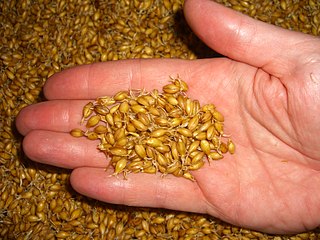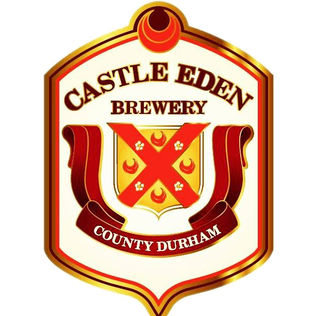
The Beeston Brewery Company (also known as the Beeston Brewery and Malting Company [1] ) was a brewery based in Beeston, Nottinghamshire, England that opened in 1880 [2] and closed in 1922.

The Beeston Brewery Company (also known as the Beeston Brewery and Malting Company [1] ) was a brewery based in Beeston, Nottinghamshire, England that opened in 1880 [2] and closed in 1922.
The Beeston Brewery Company was formed in the late 1870s, and a brewery was built in 1880 alongside the Midland Railway line between Nottingham and Derby. The company had its own railroad sidings running off the mainline.
The company had both malting and brewery functions on the same site. The architects were Wilson and Company, and the builders were Waite, Corbould, and Faulkner. It was the first brewery in England to have pneumatic maltings. [3]
In 1881, the manager was Alexander Anderson and who was replaced by Samuel Theodore Bunning in 1883. An extension to the brewery was made in 1884 and a new barley store was added in 1898. In 1889 a fire destroyed part of the complex including the pneumatic maltings, but the brewery part of the complex was saved by the local fire brigade. [4]
Bunning continued to manage the company until it was taken over by James Shipstone and Sons Limited in 1922. [5] Brewing ceased and in 1924 Shipstones converted the buildings to a maltings. The last maltings were done in 2000, after which the buildings were mothballed.
The remaining buildings survived until 2012 when demolition started. The site was cleared early in 2013.

Malt is germinated cereal grain that has been made to germinate by soaking in water and is then halted from germinating further by drying with hot air, a process known as "malting". Malted grain is used to make beer, whisky, malted milk, malt vinegar, confections such as Maltesers and Whoppers, flavored drinks such as Horlicks, Ovaltine, and Milo, and some baked goods, such as malt loaf, bagels, and Rich Tea biscuits. Malted grain that has been ground into a coarse meal is known as "sweet meal".

Beeston is a town in the Borough of Broxtowe, Nottinghamshire, England, 3.4 miles (5.5 km) south-west of Nottingham city centre. To its north-east is the University of Nottingham's main campus, University Park. The pharmaceutical and retail chemist group Boots has its headquarters 0.6 miles (1 km) east of the centre of Beeston, on the border with Broxtowe and the City of Nottingham. To the south lie the River Trent and the village of Attenborough, with extensive wetlands.

The Joseph Schlitz Brewing Company was an American brewery based in Milwaukee, Wisconsin, and was once the largest producer of beer in the United States. Its namesake beer, Schlitz, was known as "The beer that made Milwaukee famous" and was advertised with the slogan "When you're out of Schlitz, you're out of beer". Schlitz first became the largest beer producer in the US in 1902 and enjoyed that status at several points during the first half of the 20th century, exchanging the title with Anheuser-Busch multiple times during the 1950s.
Webster's Brewery was a brewery that was founded in 1838 by Samuel Webster and operated at the Fountain Head Brewery in Halifax, West Riding of Yorkshire, England. Webster's Green Label, a light mild, and Yorkshire Bitter gained national distribution after the company was taken over by Watney Mann in 1972. Throughout the 1970s it was known for the advertising slogan: "Drives out the northern thirst".

Caledonian Brewery was a Scottish brewery founded in 1869 in the Shandon area of Edinburgh, Scotland.

Genesee Brewing Company is an American brewery located along the Genesee River in Rochester, New York. From 2000 to 2009, the company was known as the High Falls Brewing Company. In 2009, High Falls was acquired by the capital investment firm KPS Capital. Together with newly acquired Labatt USA, KPS merged the two companies as North American Breweries. Along with this change, High Falls Brewery changed its name back to the original "Genesee Brewing Company" operating under the North American Breweries name. In October 2012, North American Breweries was purchased by FIFCO

Snape Maltings Concert Hall is an arts complex on the banks of the River Alde at Snape, Suffolk, England. It is best known as one of the main sites of the annual Aldeburgh Festival. It is now one of two headquarters for Britten Pears Arts, with the other being The Red House.

James Shipstone & Sons was a brewery in New Basford, Nottingham, England, that opened in 1852 and closed in 1991.

The Valentin Blatz Brewing Company was an American brewery based in Milwaukee, Wisconsin. It produced Blatz Beer from 1851 until 1959, when the label was sold to Pabst Brewing Company.

Worthington Brewery, also known as Worthington & Co. and Worthington's, was founded by William Worthington in Burton upon Trent in 1761. It is the second oldest continuously brewed British beer brand, after Whitbread. The best known Worthington beers are its Creamflow nitrokeg bitter and White Shield India Pale Ale.

The Pabst Brewery Complex, on a hill northwest of the downtown of Milwaukee, Wisconsin, is the former brewery of the Pabst Brewing Company, where the company innovated to improve their beer and increase production until in 1892 it was the largest brewer of lager in the world. In 2003 the complex was listed on the National Register of Historic Places.

A malt house, malt barn, or maltings, is a building where cereal grain is converted into malt by soaking it in water, allowing it to sprout and then drying it to stop further growth. The malt is used in brewing beer, whisky and in certain foods. The traditional malt house was largely phased out during the twentieth century in favour of more mechanised production. Many malt houses have been converted to other uses, such as Snape Maltings, England, which is now a concert hall.

Castle Eden Brewery was a brewery that operated in the village of Castle Eden in County Durham. It was best known for Castle Eden Ale, which continues to be produced at Seaham.
The Mink Building is a five-story German-American style red brick structure at 1361-1369 Amsterdam Avenue between 126th and 128th Streets, in the Manhattanville neighborhood of Manhattan, New York City, originally part of a large brewery complex. It is one of a few buildings that remain of a vast beer brewing industry in this area in the late 19th century, beer brewing was an industry as big as finance or real estate in the 21st century New York City. The site of the complex at 1361 Amsterdam Avenue in Manhattan - predating residential development in Harlem - was chosen due to its relative isolation at the time.

The Bass Maltings in Sleaford, England are a large group of eight disused malt houses originally owned by the Bass Brewery of Burton upon Trent. Constructed between 1901 and 1907 to Herbert A. Couchman's design, the maltings are the largest group of malt houses in England; they have been designated Grade II* on the National Heritage List for England, recognising them as "particularly important ... of more than special interest."

William Bradford (1845-1919) was a prolific architect of breweries. Born in 1845 in Devon, son of Robert Bradford 1818-1875. Responsible for building or altering 70 breweries his first commission was a small addition to the "Hope Brewery" in East Grinstead (1879). Died at home in Surbiton on 2 February 1919.

Evans, Cartwright and Wollatt was an architectural practice based in Nottingham from 1948 to 1961.

John Bowley LRIBA was an architect and engineer based in England who worked mainly in Beeston, Nottinghamshire and Hastings.
The city of Rochester, New York—before being known as the birthplace of Kodak, Xerox, and Bausch & Lomb—was internationally known for its robust brewing industry. Indeed, the city was uniquely positioned for such an industry in the early 19th century. The corn, rye, barley, wheat, and other grains grown in the Genesee River Valley were shipped down river to be milled in such quantity that by 1838 Rochester was world's largest flour producer, earning it the nickname the Flour City.